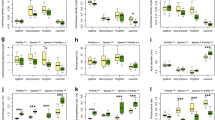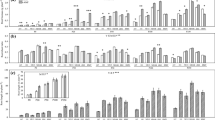Abstract
Background and Aims
Roots express morphological and physiological plasticity that may be adaptations for efficient nutrient capture when soil nutrients are heterogeneous in space and time. In terms of nutrient capture per unit of carbon invested in roots, morphological plasticity should be more advantageous when nutrient patches are stable in time, and physiological plasticity when nutrients are variable in time.
Methods
Here we examined both traits in two Pinus species, two Liquidambar species, two Solidago species, Ailanthus altissima and Callistephus chinesis, grown in pots where the same total level of nutrient addition was provided in a factorial experiment with different levels of spatial and temporal variability.
Results
Total plant root growth, Root/Shoot ratios and morphological plasticity were less when nutrients were temporally variable instead of stable. Physiological plasticity was more variable than morphological across treatments and species and was not predictably greater when nutrient supply was pulsed instead of constant. Large variability, especially in physiological plasticity, was observed, and physiological plasticity was greater in non-woody than in woody species.
Conclusions
Our results suggest that the two traits differ in environmental factors that control their expression, and that the nature of nutrient patchiness may have more direct impact on the evolution of morphological than physiological plasticity.




Similar content being viewed by others
Notes
We dripped the dyed 15N solution on a Whatman 42 filter paper and noted that the dye moved slightly more slowly than the clear solution. However, within the larger pore sizes of the sand growth medium, we believe that movement of the dye and solution should have been more synchronous. In roots, where we observed that dye moved beyond the zone of 15N exposure, we were able to identify the exposed region of roots through a magnifying lens.
References
Barber SA, Anghinoni I (1980) Phosphorus influx and growth characteristics of corn roots as influenced by phosphorus supply. Agron J 72:685–688
Bliss KM (2001) Impact of nutrient heterogeneity on plant response and competition in coastal plain species. PhD thesis, Virginia Tech, Blacksburg, VA
Böhm W (1979) Methods of studying root systems. Springer, New York
Burns IG (1991) Short-and long-term effects of a change in the spatial distribution of nitrate on the root zone on N uptake, growth and root development of young lettuce plants. Plant Cell Environ 14:21–33
Campbell BD, Grime JP (1989) A new method of exposing developing root systems to controlled patchiness in mineral nutrient supply. Ann Bot 63:395–400
Campbell BD, Grime JP, Mackey JML (1991) A trade-off between scale and precision in resource foraging. Oecologia 87:532–538
Cui M, Caldwell MM (1997) A large ephemeral release of nitrogen upon wetting of dry soil and corresponding root responses in the field. Plant Soil 191:291–299
Cui M, Caldwell MM (1998) Nitrate and phosphate uptake by Agropyron desertorum and Artemisia tridentata from soil patches with balanced and unbalanced nitrate and phosphate supply. New Phytol 139:267–272
Derner JD, Briske DD (1999) Does a tradeoff exist between morphological and physiological root plasticity? A comparison of grass growth forms. Acta Oecologica 20:519–526
Drew MC, Saker LR (1978) Nutrient supply and the growth of the seminal root system in barley. III. Compensatory increases in growth of lateral roots, and in rates of phosphate uptake, in response to a localized supply of phosphate. J Exp Bot 29:435–451
Einsmann JC, Jones RH, Mou P, Mitchell RJ (1999) Nutrient foraging traits in ten South Carolina plant species. J Ecol 87:609–619
Eissenstat DM, Yanai RD (1997) The ecology of root lifespan. Advances in Ecological Research 27:1–60
Fitter AH (1994) Architecture and biomass allocation as components of the plastic response of root systems to soil heterogeneity. In: Hutchings MJ, John EA, Stewart AJA (eds) Exploitation of environmental heterogeneity by plants. Academic, San Diego, California, pp 305–322
Fransen B, Blijjenberg J, de Kroon H (1999) Root morphological and physiological plasticity of perennial grass species and the exploitation of spatial and temporal heterogeneous nutrient patches. Plant Soil 211:179–189
Grime JP (2007) The scale-precision trade-off in spacial resource foraging by plants: restoring perspective. Ann Bot 99:1017–1021
Guo DL, Mou P, Jones RH, Mitchell RJ (2002) Temporal changes in spatial patterns of soil moisture following disturbance: An experimental approach. J Ecol 90:338–347
Hodge A (2004) The plastic plant: root responses to heterogeneous supplies of nutrients. New Phytol 162:9–24
Hodge A (2009) Root decisions. Plant Cell Environ 32:628–640
Hodge A, Berta G, Doussan C, Merchan F, Crespi M (2009) Plant root growth, architecture and function. Plant Soil 321:153–187
Hutchings MJ, de Kroon H (1994) Foraging in Plants: The role of morphological plasticity in resource acquisition. Advances in Ecological Research 25:159–238
Hutchings MJ, John EA (2003) Distribution of roots in soil, and root foraging activity. In: de Kroon H, Visser EJ (eds) Root ecology. Berlin: Springer-Verlag, Berlin, pp 33–60
Hutchings MJ, John EA (2004) The effects of environmental heterogeneity on root growth and root/shoot partitioning. Ann Bot 94:1–8
Jackson RB, Manwaring JH, Caldwell MM (1990) Rapid physiological adjustment of roots to localized soil enrichment. Nature 344:58–60
Jackson RB, Caldwell MM (1993a) The scale of nutrient heterogeneity around individual plants and its quantification with geostatistics. Ecology 74:612–614
Jackson RB, Caldwell MM (1993b) Geostatistical patterns of soil heterogeneity around individual perennial plants. J Ecol 81:683–692
James JJ, Mangold JM, Sheley RL, Svejcar T (2009) Root plasticity if native and invasive Great Basin species in resonse to soil nitrogen heterogeneity. Plant Ecol 202:211–220
James SE, Pärtel M, Wilson SD, Peltzer DA (2003) Temporal heterogeneity of soil moisture in grassland and forest. J Ecol 91:234–239
Kembel SW, Cahill JF (2005) Plant phenotypic plasticity belowground: A phylogenetic perspective on root foraging trade-offs. Am Nat 166:216–230
Kembel SW, de Kroon H, Cahill JF, Mommer L (2008) Improving the scale and precision of hypotheses to explain root foraging ability. Ann Bot 101:1295–1301
Lister AJ, Mou PP, Jones RH, Mitchell RJ (2000) Spatial patterns of soil and vegetation in a 40-year-old slash pine Pinus elliottii. forest in the Coastal Plain of South Carolina, U.S.A. Can J For Res 30:145–155
Lodge DJ, McDowell WH, McSwiney CP (1994) The importance of nutrient pulses in tropical forests. TREE 9(10):384–387
McConnaughay KDM, Bazzaz FA (1992) The occupation and fragmentation of space: Consequences of neighbouring roots. Funct Ecol 6:794–710
Mou P, Jones RH, Mitchell RJ, Zutter B (1995) Spatial distribution of roots in Sweetgum and Loblolly Pine monocultures and relations with above ground biomass and soil nutrients. Funct Ecol 9:689–699
Mou P, Mitchell RJ, Jones RH (1997) Root distribution of two tree species under a heterogeneous nutrient environment. J Appl Ecol 34:645–656
Peterjohn WT, Correll DL (1984) Nutrient dynamics in an agricultural wetland: observations on the role of a riparian forest. Ecology 65(5):1466–1475
Sardans J, Rodà F, Peñuelas J (2006) Effects of a nutrient pulse supply on nutrient status of the Mediterranean trees Quercus ilex ssp. ballota and Pinus halepensis on different soils and under different competitive pressure. TREES-Structure and Function 20(5):619–632
Snyder KA, Williams DG (2003) Defoliation alters water uptake by deep and shallow roots of Prosopis velutina Velvet Mesquite. Funct Ecol 17:363–374
Van der Werf A, Kooijman A, Welschen R, Lambers H (1988) Respiratory energy costs for the maintenance of biomass, for growth and for ion uptake in roots of Carex diandra and Carex acutiformis. Physiol Plant 72:483–491
Wang L, Mou P, Jones RH (2006) Nutrient foraging via physiological and morphological plasticity in three plant species. Can J For Res 36:164–173
Wijesinghe DK, John EA, Beurskens S, Hutchings MJ (2001) Root system size and precision in nutrient foraging: responses to spatial pattern of nutrient supply in six herbaceous species. J Ecol 89:972–983
Wijesinghe DK, John EA, Hutchings MJ (2005) Does pattern of soil resource heterogeneity determine plant community structure? An experimental investigation Journal of Ecology 93:99–112
Zhang HM, Rong H, Pilbeam D (2007) Signaling mechanisms underlying the morphological responses of the root system to nitrogen in Arabidopsis thaliana. J Exp Bot 58:2329–2338
Acknowledgements
We appreciate the extensive helps from the graduate students in Mou’s lab during the tedious and labor intensive plant harvest and root sorting works, they are: Y. Li, F. Hu, P. Wang, Y. Wang, Y. Pan, S. Li, J. Yang. Our thanks extend to the Isotope Mass Spectrometry Laboratory of the Chinese Forestry Academy for the technical support in sample 15 N analysis. This study was supported by the National Science Foundation of China (NSFC) grants (grants 30830024 31121003 30770330). The clarity and strength of the manuscript benefited greatly from the suggestions by 2 anonymous reviewers.
Author information
Authors and Affiliations
Corresponding author
Additional information
Responsible Editor: Alain Pierret.
Rights and permissions
About this article
Cite this article
Mou, P., Jones, R.H., Tan, Z. et al. Morphological and physiological plasticity of plant roots when nutrients are both spatially and temporally heterogeneous. Plant Soil 364, 373–384 (2013). https://doi.org/10.1007/s11104-012-1336-y
Received:
Accepted:
Published:
Issue Date:
DOI: https://doi.org/10.1007/s11104-012-1336-y




